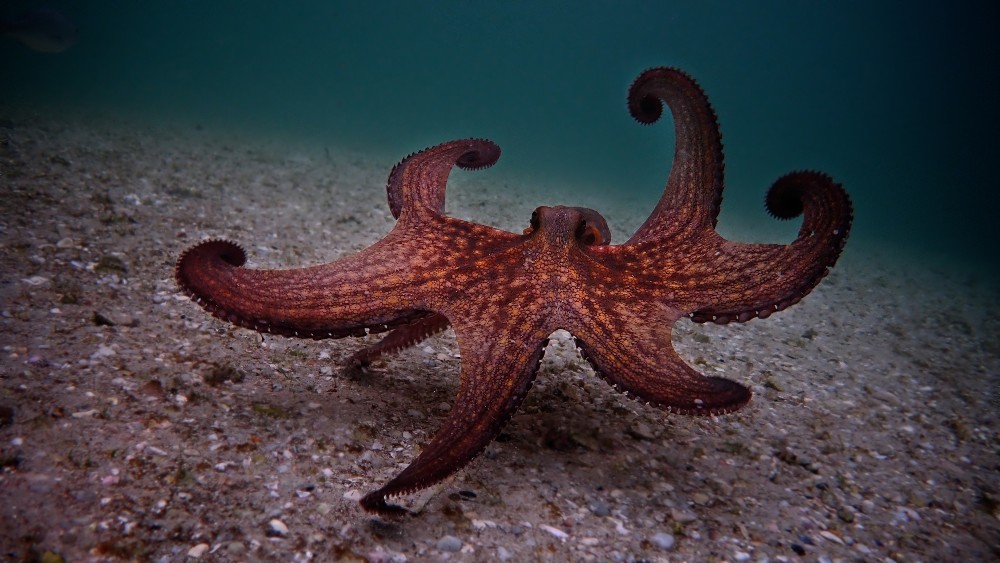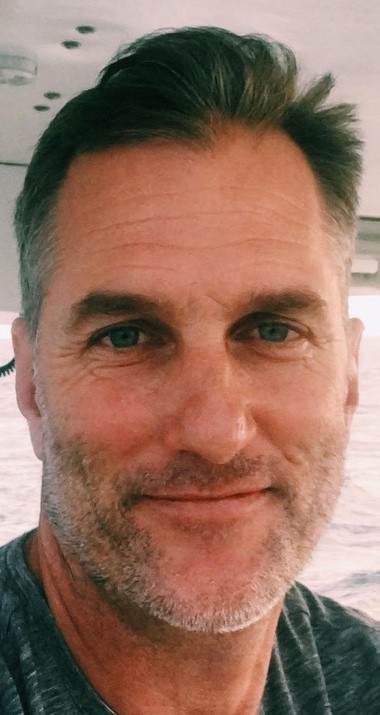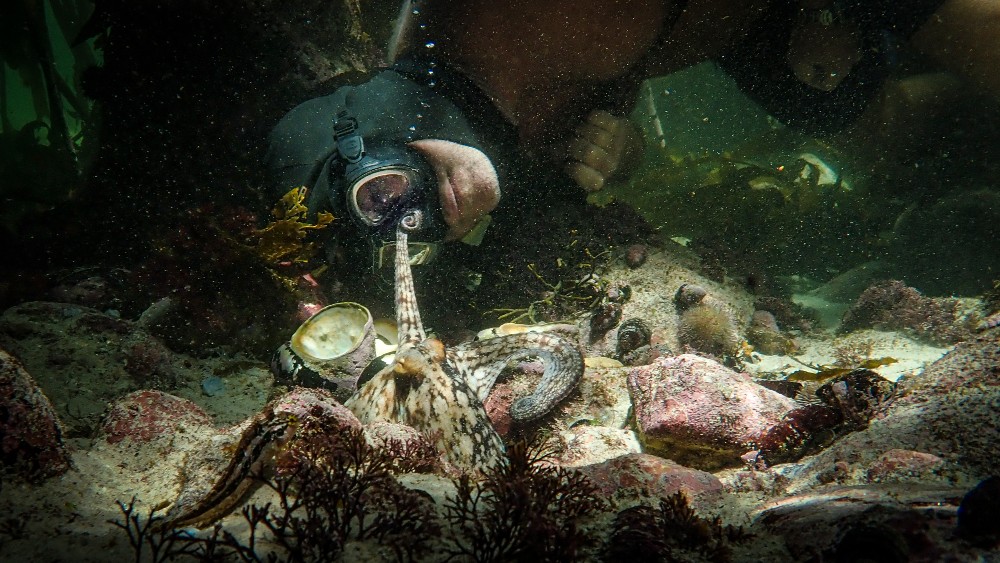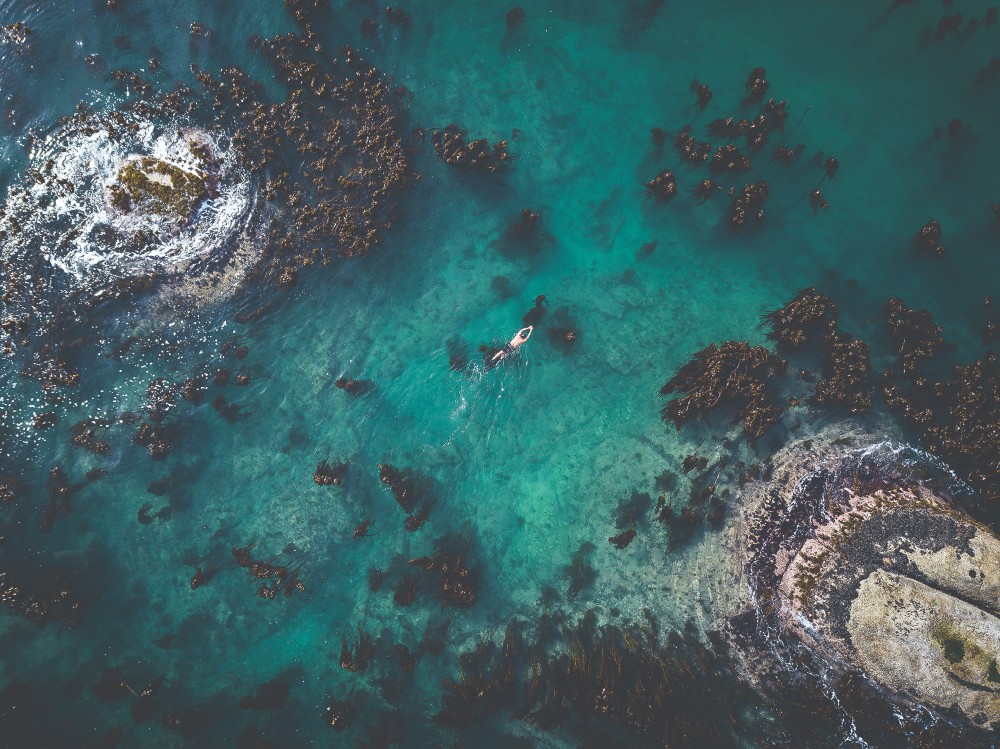
When it comes to documentaries, the importance of having a great cinematographer often gets overlooked compared to their contribution to artier narrative fare. When you have a doc like Pippa Ehrlich and James Reed’s My Octopus Teacher, where so much of the film takes place underwater, you need to have an able underwater cinematographer to capture the story being told.
My Octopus Teacher tells the story of filmmaker Craig Foster, who decided to take a break from filmmaking by snorkeling in the kelp forests off the coast of his hometown of Cape Town, South Africa. For almost a decade he would take daily trips into the cold water, and there, Foster encountered an octopus that would show him what few other humans have experienced. Eventually, Foster called upon Roger Horrocks, the DP of some of his earlier films, to go into the ocean with him to capture and document this unlikely friendship that was turning into a deeply moving nature story.
It’s probably little surprise that Foster’s story in My Octopus Teacher has connected with both critics and people in the film industry, having won the BAFTA Award for Best Documentary over the weekend and why it’s nominated for an Oscar in the same category.
Below the Line spoke with Horrocks over the phone from his home in South Africa to learn more about what was involved with shooting My Octopus Teacher.

Below the Line: Before we get into My Octopus Teacher, what originally got you into underwater photography and filming? When and how did that start?
Roger Horrocks: Yeah, that’s a good question. I was actually involved in corporate for 10 years. I worked in digital and financial services, but I grew up on the coast, spearfishing, and just had great, passionate memories of the ocean and a deep connection with the ocean. I was doing an MBA and that made me realize that I did not want to be in corporate anymore. I then reconnected with some of my old spearfishing friends and through them actually got work as an assistant on one of the BBC series, Nature’s Great Events, and you know how it works. It’s an apprenticeship model, and through that, I met Didier Noirot, who was Jacques Cousteau’s cameraman. We became good friends, and he really became a mentor. Once that happens, you realize that it’s just doing your apprenticeship, and then eventually, you get the chance to start shooting yourself.
BTL: I assume there are different types of lenses and cameras, when you’re working underwater. Did that experience as an apprentice get you more knowledgeable about that?
Horrocks: Yeah, very much. so. I mean, you learn on the field. You obviously do all the prep. It’s exactly like in the features world, you work your way up through the different sort of levels. Because our teams are so much smaller, you start pretty much as an assistant, and then eventually, after 5, 6, 7, 8 years of doing that, you get your chance to shoot. If that’s acceptable and on level, then you start to get work as a shooter.
BTL: Craig kind of started on this, filming himself, so at what point did you come on and did he bring you on, or did Pippa and James come to you?
Horrocks: Craig had very much gone through this sort of journey. We actually met in 2006. We’d actually made three films together over that period, up until about 2011. In fact, he mentions the burnout. It was on those projects, that he got burnt out, the projects that we worked on together. But he then got very involved in the kelp forests, as the film shows, going in every day and starting to learn. I was looking for a story to shoot for Blue Planet 2, the big BBC series. He had mentioned to me that he had started to uncover the secrets of the kelp forests, and we actually started working together on that sequence for Blue Planet 2. In that process, we shot a massive archive of material, which is what enabled us to make… a lot of the footage for My Octopus Teacher came from that critical period of documentation.
BTL: Did James get involved because Craig had gotten burnt out?
Horrocks: No, I think it was as the idea for the film became more and more stronger in his mind, Craig really needed help. It’s very difficult to be in a movie, to shoot it, and to edit it yourself. I think Pippa was really instrumental in coming in and really helping him to start to work the story. It was very much a project he was kind of doing for himself, and then when Netflix got involved — as I understand it, because I wasn’t super-involved in that process, I’d really delivered a lot of the material. They brought James on right towards the end to really give it a structure. I think he was instrumental in that interview process. He did the interviews with Craig and created that backbone for the film. It was a wonderful kind of collaboration of different people. You know, often too many cooks spoil the broth, but I think in this case, it really enhanced the broth fantastically well.
BTL: Structure may be the most important part of documentary filmmaking, because you can have a lot of great interviews and a lot of great footage, but if you can’t tie it all together, it won’t work.
Horrocks: Exactly, exactly. As I say, I’ve worked with Craig, and I’ve seen the evolution of these stories. What I love about the film, because in a way I shot it, I did the material, then I moved away from it, but it’s an archetypal story structure, isn’t it? It’s like a man or a person around the campfire telling this brilliant story, this emotive story, and it’s so simple in its structure and yet so powerful in a way.
BTL: How much time did you spend underwater filming Craig and his friend? How much footage did you end up with?
Horrocks: I think in that process, we must have just together done probably about 80 days over a period of time, and then obviously Craig was going in every day There was quite a massive amount of material to choose from. I was shooting on a Red Dragon, and then he was shooting primarily on his Panasonic G-Tough, that small little camera but it has an incredible macro ability. We sort of evolved the style of shooting just through… we’d go and shoot and then we’d come back, and we would download and we would correct proxies and then go through every single bit of footage and log it and discuss it. Out of that emerged the kind of visual style of the film I guess, to a degree.

BTL: I’m sure a lot of people ask you this but what sort of prep do you have to do with the camera to be able to take it sometimes pretty deep underwater?
Horrocks: I use Nauticam housings, they’re really brilliant. It’s basically an all-mechanical interface. So you’ve got your Red inside an aluminum housing with a really good dome, so your optics are good. It becomes second nature. To be honest, I can’t dive now without a camera. I kind of feel uncomfortable. It’s quite big, but it’s become such a fundamental part of me. I’ve been shooting now for 15 years as a cameraman, so it’s just completely second nature. But that’s it. I mean, basically, it’s no different from shooting above water, except that you can’t change lenses. You’re kind of stuck with that one lens that you choose to take under for that dive.
BTL: That was my next question: What happens if you want to change lenses? Do you just go up or just change things for the next day’s shoot?
Horrocks: That’s exactly what I’ve done now. I’ve actually invested, so I have three Red bodies now, so I have the luxury of being able to take two systems with me. That means that I can be covered from say 10mm to 70mm, which is just so fantastic, because it means that in a given scenario, you can get the tight coverage, you can get the wide coverage. But the go-to lens we used was the Nikon 1755. Ironically, we use stills glass behind a dome because it resolves better than PL glass behind a dome, but that was my go-to classic photojournalist lens, in full-frame would be like a 24 to 70.
BTL: This film is so intimate in capturing this relationship that Craig has with the octopus, so it’s just the two of you. You don’t have any crew or anyone else there to help with the shoot?
Horrocks: No, it was very much just the two of us, and then obviously Craig, when he was going in on his own, just freediving, he’d be setting his camera up on a rock and then filming himself or just filming close-ups of his eyes or his hands. I think that was key. I try as much as possible to minimize the amount of people in the water, because it definitely has a kind of energetic impact on the animals, for the negative.
BTL: As far as lighting the film, do you have lights with you down there especially in the darker areas of water?
Horrocks: No, I’m violently — when I say “violently” it’s a strong word — but I’m very opposed to using any form of lights underwater. We were diving shallow. There was no need for lights, and it really was just a case of trying to make the most… and I mean you’ve seen the material. That kelp forest in the late afternoon and early morning with the rays of light and then it’s just such an incredible place. The problem underwater with lighting is you get what’s called back scatter, so you pick up a lot of particulate. If I do use lights, I don’t want anyone to be able to see that I’m using lights to create a bit of shadow or shaping the lights in any way, but no, I’ve never used lights. Well, certainly on this film I definitely didn’t use any lights.
BTL: But that limits you to daytime shooting, doesn’t it?
Horrocks: Yeah, very much so. Also on this project, we were really shooting around the low tide, because it was the calmest. That was one of the big challenges, of course, is that you’re in a shallow with rusty and swell and trying to keep things stable. That’s why the documentary-style really worked well. Even when I was shooting on the long lens, I was actually using a Nikon 70 to 180 macro lens to get some of the real tights. I actually avoided using a tripod, just because I wanted to kind of keep that slacky, more reportage feel running through the film. Yeah, it worked really well.
BTL: Did that help with holding things steady when you have waves or other underwater movement?
Horrocks: You’d think that you want tank-like conditions, but of course, when you’ve got tank-like conditions, there’s no sediment, there’s nothing moving around — the whole energy, the visual interest of the screen just fades. So that was one of the benefits, obviously, on the Red is we could overcrank — we can shoot 80 frames, 90 frames a second, going really, really tight, and you’d get these incredible moments. If you shot three minutes, you might only get literally four or five seconds of usable material that was sharp and working and really in focus, but it’s just absolutely magical. The key always is not for the viewer to see or to notice the slow motion. You’re not using it to try and say, “Hey, look at this, this is slow motion.” You just want to allow enough time for the viewer to see the octopuses’s eye up close, for example. It was an interesting journey of learning, as you go in tighter, the different frame rates that would work and it then would cut with material that was shot in real-time without there being any sort of sense of disconnect.
BTL: You were changing frame rates while framing, so that stuff wasn’t done in post?
Horrocks: No, no, no. You obviously don’t want to violate the 180 rule from a technical perspective. So you really want to try and dial in your frame rates — you definitely don’t want to be doing that in post. I mean, you can. So for example, sometimes, if you think the producer might want to use it slow, you can shoot at 60, and then they can speed it up to 30. But you definitely don’t want to go from like 90 to 30, because then the image will be too sharp and things like that. I always spend quite a lot of time trying to work out which subject, which speed, which frame size, and then which frame rates will be optimal for that.
BTL: Did Craig film the testimonials himself or did that come about when Pippa and James came on board? Was he telling the story after all the filming had already been done?
Horrocks: Yeah, that was kind of his reflection on that whole journey. That was you know more towards the end of the production cycle.
BTL: I’m sure this was the case when Jaques Cousteau was very popular on TV, but have you found that a lot of people are getting into scuba after watching these movies you make, wanting to experience those worlds for themselves?
Horrocks: I think COVID had a lot to do with it. I don’t know if it’s been the same there, but there’s been a massive explosion of people cycling and snorkeling and if you go down to the beach now early in the morning, there’s way more people going in and snorkeling in the kelp forests and things like that. Definitely, the film helped with the snorkeling, but COVID, in general, has definitely evoked that people just getting out more and just really appreciating nature more.
BTL: I guess it goes without saying that the ocean is fairly COVID-free?
Horrocks: Exactly. It’s much better. COVID free and it’s cold, which obviously has all those benefits, all that cascade of goodness into your body that Craig speaks about in the film. It really is.
BTL: I saw that you have a company that sells stock underwater footage, so have you been shooting stuff this whole time while working on other things?
Horrocks: Yeah, I’ve been very fortunate. I’ve worked as a shooter for BBC Netflix, I’ve actually been working primarily for Netflix since 2019, 20. I’m now working on a big ocean series for Netflix. Unfortunately, you can’t travel very well, but in South Africa, there’s just so many great stories. I’ve been very busy the last two years, even during lockdown, which has been wonderful
BTL: What would you like people to get out of this movie when they watch it?
Horrocks: Really just for me, one of the great privileges I’ve had is to spend a lot of time with dolphins in the ocean and just the realization that the gradient that separates animals and us is actually very small. We are so like them, and they are so like us. Once you start to feel that empathy, and I remember one critic described My Octopus Teacher as an empathy engine, and I thought that was a brilliant insight into the power of the film. For me, that’s what it’s all about. It’s about opening your heart and connecting with things that you wouldn’t normally connect with. That, for me, is the great insight of the film.
My Octopus Teacher is now streaming on Netflix.
All photos courtesy of Netflix, photos by Tom Foster. (Click on photos for larger versions.)






